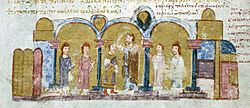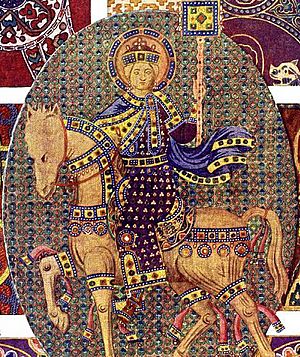John I Tzimiskes facts for kids
Quick facts for kids John I Tzimiskes |
|
|---|---|
| Emperor and Autocrat of the Romans | |

Detail of the Gunthertuch, a Byzantine silk tapestry depicting John Tzimiskes being greeted by the Blues and Greens at a triumph.
|
|
| Byzantine emperor | |
| Reign | 11 December 969 – 10 January 976 |
| Coronation | 19 December 969 |
| Predecessor | Nikephoros II Phokas |
| Successor | Basil II |
| Born | 925 (now Çemişgezek, Tunceli Province, Turkey) |
| Died | 10 January 976 (aged 51) Constantinople (now Istanbul, Turkey) |
| Spouse | Maria Skleraina Theodora |
| Dynasty | Macedonian |
John I Tzimiskes (born around 925, died January 10, 976) was a powerful Byzantine emperor who ruled from 969 to 976. He was a very skilled general who helped make the Byzantine Empire stronger and larger. He fought important wars against the Rus' people and the Fatimids, expanding the empire's lands into Thrace and Syria.
Contents
About John Tzimiskes
John was born in a place that is now called Çemişgezek in Turkey. His family, the Kourkouas, was a very important military family in the Byzantine Empire. His mother was from the Phokas family, another strong military family.
The name "Tzimiskes" might have come from an Armenian word meaning "red boot" or "short stature." Some historians also think it came from the region where he was born.
John was described as a short but strong man with reddish-blonde hair and blue eyes. He joined the army when he was young. His uncle, Nikephoros Phokas, taught him a lot about warfare. Because of his family and his own skills, John quickly became a high-ranking general. He was in charge of the army in Armenia before he was 25 years old.
He married Maria Skleraina, who was known for her beauty and wisdom. She died before he became emperor, and they did not have any children.
How John Became Emperor
The Byzantine Empire was often at war with its neighbors to the east, especially the Hamdanid kingdom. Armenia was a border area, and John successfully defended it. He fought alongside his uncle, Nikephoros Phokas, and also led parts of the army himself. He was very popular with his soldiers because he was brave and often turned battles around.
In 962, the Hamdanids made peace with the Byzantines. This made the eastern border safe for a few years.
After Emperor Romanos II died in 963, John encouraged his uncle Nikephoros to become emperor. John helped Nikephoros gain the throne and continued to protect the empire's eastern lands. However, later on, John lost his military command due to some political plotting. In response, he joined a plan with Nikephoros's wife and other generals to remove Nikephoros from power.
John's Time as Emperor

After he became emperor in December 969, John quickly worked to make his position secure. He sent his brother-in-law, Bardas Skleros, to stop a rebellion by his cousin, Bardas Phokas, who also wanted to be emperor. To further strengthen his rule, John married Theodora, who was the daughter of a previous emperor, Constantine VII.
John then focused on protecting the empire from outside invaders. He made a peace treaty with Aleppo, securing the eastern border.
Fighting the Rus'

Early in his reign, John had to deal with the Kievan Rus' people who were moving into the Byzantine lands near the Danube River. In 970, he sent his brother-in-law, Bardas Skleros, to push the Rus' out of Thrace. Skleros defeated the Rus' army in a battle at Arcadiopolis.
In 971, John Tzimiskes led the main Byzantine army across the mountains. He then surrounded the fortress of Dorostolon (now Silistra) on the Danube River. After 65 days of fighting, he defeated Grand Prince Sviatoslav I of Kiev. John and Sviatoslav made a truce, where the Rus' left the area in exchange for supplies.
Expanding the Empire

When John returned to Constantinople, he celebrated a great victory parade. He also made the Church of Christ of the Chalke bigger to show his thanks. He took away the symbols of power from the captured Bulgarian Emperor, Boris II, and announced that Bulgaria was now part of the Byzantine Empire. To make his northern border even safer, he moved some groups of people called Paulicians to Thrace.
In 972, John Tzimiskes turned his attention to the Abbasid Empire and its smaller kingdoms. He invaded Upper Mesopotamia. In 975, he led another campaign into Syria. His forces captured many important cities like Emesa, Baalbek, Damascus, and Tripoli. However, he was not able to capture Jerusalem.
John's Death
John Tzimiskes died suddenly in 976, after returning from his second campaign against the Abbasids. He was buried in the Church of Christ Chalkites, which he had rebuilt. Some historical records suggest that a high-ranking official named Basil Lekapenos may have poisoned the emperor. This was possibly to stop John from taking back lands and riches that Lekapenos had unfairly gained.
John Tzimiskes left all his own money to help the poor and the sick. His nephew, Basil II, who had been a co-emperor, became the next emperor. John left behind an empire that was stronger and larger than before.
Legacy
A main shopping street in the city of Thessaloniki, Greece, is named Tsimiski Street after him. Also, the town of Çemişgezek in Turkey, where he was born, is named after him.
See also
 In Spanish: Juan I Tzimisces para niños
In Spanish: Juan I Tzimisces para niños





